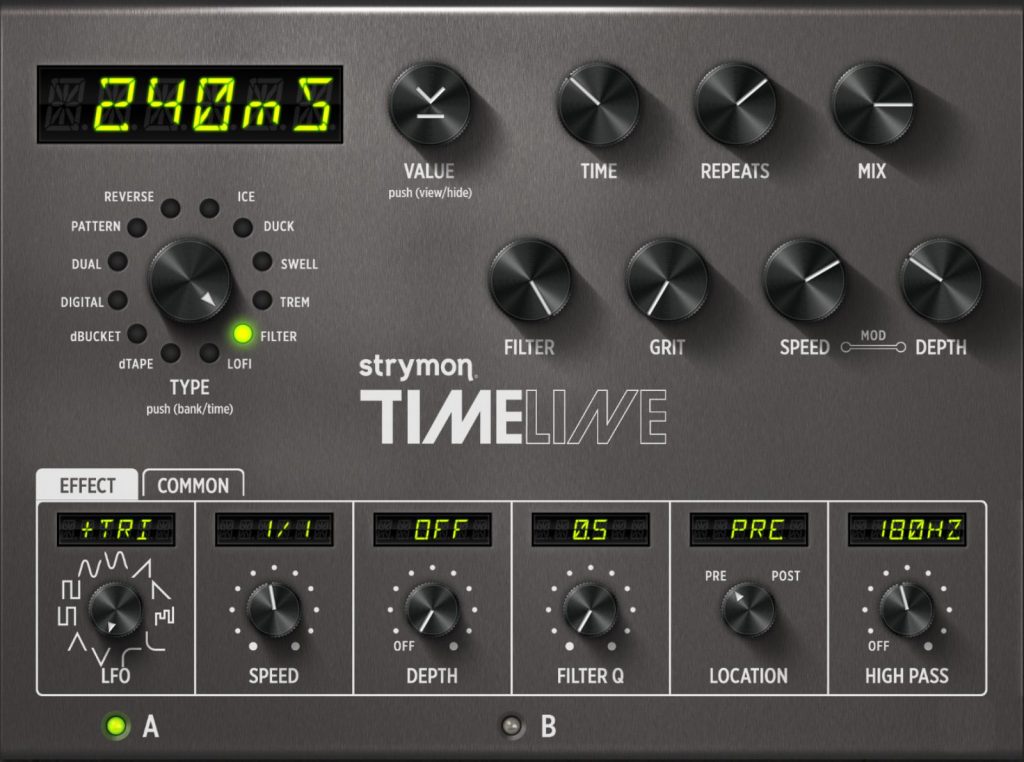
This Week’s Preset: TimeLine – “Touch Sensitivity”
If you haven’t spent much time with the Duck delay machine within TimeLine, you should definitely devote some time to exploring the options! Ducking delays
Free US Shipping On Orders Over $49
Easy 30-Day Returns
Financing Available Through ![]()

You’ve heard of tape delays, bucket brigade delays, and digital delays. Maybe you’ve also heard of oil can delays…or maybe not! Oil can delay? Yup. Some vintage guitar effects enthusiasts reading this may have played through one or seen them demonstrated in YouTube videos. (Do any of you out there own one?) Both software and hardware emulations are available today, and there are still original units out in the wild, ready to be snatched up and repaired (if needed) by folks with a hankering for the real deal. And yes, an oil can is involved, sort of.
Created in the early 1960’s by Ray Lubow, co-founder of Tel-Ray (which would eventually produce the Morley product line), oil can delays were sold under the Tel-Ray name as various Ad-n-Echo and Organ Tone models. The Tel-Ray oil can delay technology was also provided for use in products such as the Fender Echo Reverb, Fender Dimension IV, and the Gibson Reverb Echo (to name a few), as well as being included inside some amplifier models. There was also the Morley Electrostatic Delay Line, and even a pedal version: the (somewhat gigantic) Morley EVO-1 Echo Volume pedal. The EVO-1 is a guitar effects pedal with an AC motor inside!
Inside an oil can delay unit is something that looks kind of like a can of tuna. But instead of tuna (because that would be silly), inside that drum is a rotating disk coated with oil which can store a charge electrostatically. The charge is the AC audio signal (from the guitar), delivered by a conductive wiper to the oily disk. The stored charge is then “read” by a second wiper (acting like an electrostatic pickup or playhead) and the resulting signal is amplified and mixed with the input signal. As is often the case in vintage technology, imperfections provide the charm! Inconsistencies in the oil can delay’s electrostatic-mechanical system (such as the running of the AC motor, the rubber drive belt, and the dripping oil) worked together to produce a dark, warbly, pitch vibrato drenched delay. The sonic output of this oily analog process can also vary substantially depending on the condition of the unit, the oil, etc.
To get a dark delay sound, the Filter delay machine has been used, but with no modulation of the filter cutoff frequency. The speed and depth knobs (which control the delay time modulation) are set to approximate the natural pitch vibrato inherent in oil can delays. I roughly matched the modulation speed with the delay time, since in a real oil can delay both parameters relate to the speed of rotation of the disk. Note that with the Morely EVO-1 for example, the delay time of the first repeat could be adjusted, essentially by changing the distance between the read and write wipers. Subsequent repeats would happen at the rate of rotation regardless of wiper distance.
The image below shows the knob settings and parameters for the preset. Note that the LFO waveform and LFO speed are not shown, since they don’t matter at all with LFO depth set to “OFF” as it is in this patch.

Using the Strymon Librarian or our new Nixie preset editor? Download the preset and load it into your TimeLine.
Do you have an oil can delay at home? Can you tweak this preset to make it sound more like your own oil can delay? If so (or if you have any other tweaks for this preset), please post your version below! Are there other preset types that you’d like to see in upcoming blog posts? Let us know what you think. Thanks!
Big thanks to Strymon Customer Support Specialist Matt Alegrete for doing most of the work on this patch before handing it off to me, and for the great idea to do an oil can delay preset!
Subscribe to our newsletter to be the first to hear about new Strymon products, artist features, and behind the scenes content!

If you haven’t spent much time with the Duck delay machine within TimeLine, you should definitely devote some time to exploring the options! Ducking delays

Today we’re going to focus on crushing some bits. Basically making things sound as bad as possible—but in a good way of course. Here’s how

One of my favorite things to do with TimeLine is to use the Lo-Fi machine to corrupt my signal, and then soften it up with
5 Responses
I’ve owned and used and repaired these “oil-can” delays (60 years an electronic tech).I remember paying $32. for a quart of the oil they used! Oh well!!
I am really grateful to the owner of this website who has shared this
great piece of writing at here.
Hi do you know of where I could get parts for a Oilcan delay I have a Morley oil can delay out of the 1975 and it’s in rough shape my email is chrisfierochw@ yahoo.com
Unfortunately not. eBay and other gear forums may be your best bet, but we wouldn’t be able to be of much help past that. Sorry about that!